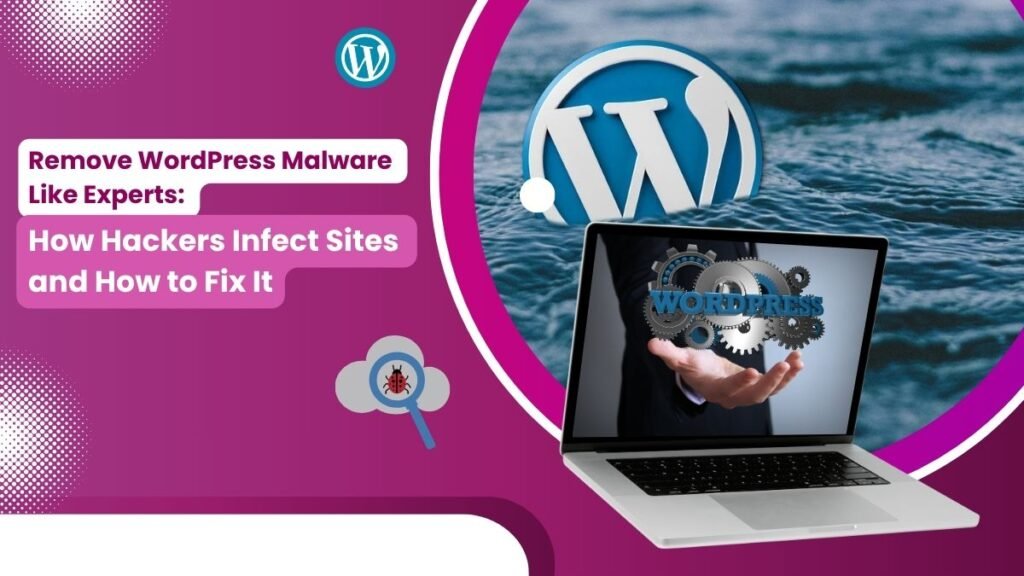If your WordPress site suddenly starts acting up and starts redirecting to sketchy websites, showing strange pop-ups, or loading slowly, it might be a clear sign that your site has been infected. Malware can hit any WordPress site, big or small. And when it does, it hurts more than just your site; it damages trust, SEO rankings, and even revenue.
In this blog, we’re analysing how hackers typically infect WordPress websites, how to remove WordPress malware thoroughly, and how to lock your site down with proper WordPress maintenance practices so it never happens again.
The Silent Invasion: How Malware Slips Into WordPress Sites
Hackers don’t always announce their arrival. Malware sneaks into your WordPress site through backdoors that seem harmless on the surface.
Here’s how it usually happens:
- Outdated plugins or themes: These are the number one cause of infections. If a vulnerability exists in a plugin or theme you’re using, and it’s not updated, hackers can exploit it to inject malicious code.
- Nulled plugins or themes: Free versions of premium plugins or themes downloaded from shady websites often come with malware baked in.
- Weak admin credentials: If your password is “admin123,” you’re inviting hackers in.
- Improper file permissions: Files and folders with overly permissive settings are a goldmine for attackers.
- No firewall or security plugin: If your site doesn’t have a proactive security setup, it’s like running a store with the doors wide open.
Once inside, malware can do a lot of damage, create hidden users, inject spammy links, or even redirect your traffic to phishing pages.
Signs Your WordPress Site Is Infected
Before learning how to remove WordPress malware, it’s important to recognize the symptoms. Some infections are visible, while others lurk in the code.
Common signs of infection include:
- Website redirects to unrelated or harmful sites
- Sudden drop in website speed
- Unexplained changes in website content
- New admin users you didn’t create
- Google blacklists your site
- The hosting provider disables your account.
How to Remove WordPress Malware Like a Pro
Here’s a thorough, step-by-step process to remove WordPress malware safely and completely.
1. Backup Your Site Immediately
Before touching anything, create a full backup of your current website. Even though it’s infected, it’s good to have a copy in case something goes wrong during cleanup.
2. Put the Site in Maintenance Mode
You don’t want users interacting with a compromised site. Switch to maintenance mode using a plugin or a simple HTML message.
3. Install a Reputable Security Plugin
Use plugins like Wordfence or Sucuri. These tools scan your entire file structure and database for malicious code.
4. Manually Inspect Key Files
Check files such as wp-config.php, .htaccess, and those inside /wp-content/uploads/ for suspicious code. Hackers often hide base64-encoded scripts or unfamiliar PHP injections in these locations.
5. Replace Core WordPress Files
Delete everything except the wp-content folder and wp-config.php file, and upload a fresh version of WordPress from WordPress.org. This ensures all core files are clean.
6. Reinstall Plugins and Themes
Delete all plugins and themes. Only reinstall those from the official repository or verified premium sources. No nulled stuff.
7. Reset All Passwords and Check Users
Force-reset passwords for all users, especially administrators. Remove any user accounts you don’t recognize.
How to Make Sure Malware Is 100% Gone
Just removing visible signs isn’t enough. You need to ensure the infection hasn’t left behind any backdoors.
- Rescan the site after cleanup using multiple scanners (Wordfence, Sucuri, VirusTotal).
- Monitor traffic and behavior in Google Search Console.
- Look through server logs for any strange or repeated requests.
- Check for unauthorized cron jobs or scheduled tasks in cPanel or WordPress.
If you’re unsure, the safest route is to work with professionals like HireWPExperts, who specialize in deep malware removal, security hardening, and complete WordPress maintenance.
Why Proper WordPress Maintenance Is Key to Prevention
Once your site is clean, you want to keep it that way. Here’s where solid WordPress maintenance steps in. Maintenance isn’t just about performance; it’s your front-line defense against future attacks.
- Regular plugin/theme updates: Hackers target known vulnerabilities. Don’t give them an opening.
- Daily backups: Always have a clean restore point ready.
- Install a security plugin with a firewall: Real-time threat detection is a must.
- Limit login attempts and use 2FA: Don’t let brute force attacks win.
- Use only trusted sources: Never install plugins or themes from shady marketplaces.
Regular upkeep saves time, money, and your reputation. Most attacks happen because sites are left unprotected, not because hackers specifically chose you.
How Do These Attacks Occur?
Hackers send bots across the web looking for WordPress sites with security holes. You don’t need to be a major company or a popular blog to get hit. If your site is outdated or poorly protected, it goes on their automated target list.
Just one missed update or weak plugin can become an entry point. Once hackers get in, they can use your site to spread viruses, trick visitors, or attack other websites.
Final Thoughts
Malware is annoying, but not the end of the world. Act fast, stay updated, and build good security so you can bounce back from any attack and keep your WordPress site running well.Fixing a hacked website feels overwhelming, but with proper steps and help, you can restore and protect your online presence. Don’t wait for your site to crash or your search rankings to drop; treat WordPress maintenance as a must-have part of your online plan. Contact HireWPExperts to get back to running your malware-free business.

